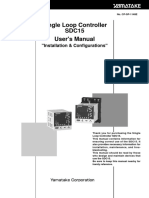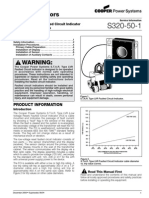Voltage Regulators: Product Information Procedure Instructions
Voltage Regulators: Product Information Procedure Instructions
Uploaded by
sincos1983Copyright:
Available Formats
Voltage Regulators: Product Information Procedure Instructions
Voltage Regulators: Product Information Procedure Instructions
Uploaded by
sincos1983Original Title
Copyright
Available Formats
Share this document
Did you find this document useful?
Is this content inappropriate?
Copyright:
Available Formats
Voltage Regulators: Product Information Procedure Instructions
Voltage Regulators: Product Information Procedure Instructions
Uploaded by
sincos1983Copyright:
Available Formats
Voltage Regulators
Service Information
Procedure to Free a Stalled Tap-Changer
Product Information
Introduction
Service Information S225-60-7 provides instructions to
free a tap-changer stalled between positions with the
holding switch closed.
Refer to S225-10-30, VR-32 Voltage Regulator with
Quik-Drive Tap-Changer Installation, Operation, and
Maintenance Instructions and S225-11-1, CL-6 Series
Control Installation, Operation, and Maintenance
Instructions for detailed service information on Cooper
Power Systems voltage regulators and controls.
Read This Manual First
Read and understand the contents of this manual and
follow all locally approved procedures and safety practices
before installing or operating this equipment.
Additional Information
These instructions cannot cover all details or variations
in the equipment, procedures, or processes described
nor provide directions for meeting every possible
contingency during installation, operation, or maintenance.
For additional information, contact your Cooper Power
Systems representative.
Standards
ISO 9001 Certified Quality Management System
S225-60-7
procedure instructions
1. To determine if the tap-changer is stalled between
tap positions with the holding switch closed, check
the voltage on the L1 or R1 terminals on the back
panel. This is done by touching one lead from an
AC voltmeter to ground and the other to either L1
or R1. Whichever position reads approximately
120 volts is the direction the tap-changer was
moving when stalling occurred. Note there will, in
all likelihood, be a floating capacitive voltage on the
other direction. Record this voltage level. Once it has
been determined that the tap-changer is stalled, the
following steps can be used to reverse the direction
of the tap-changer to free the mechanism.
2. Place the Auto/Remote/Manual switch into the OFF
position.
3. Place the Internal/External switch into the OFF
position.
4. Close the C (CT) shorting switch on the back panel
of the control.
5. Open the V1 disconnect switch on the back panel of
the control, removing power from the control.
6. Disconnect the orange wiring harness lead from the
HS terminal on the bottom of terminal board (TB1)
that is located on the back panel of the control,
thus removing power from the tap-changer holding
switch.
7. Close the V1 disconnect switch.
8. Place the Internal/External power switch on Internal.
9. Place the Auto/Manual switch on Manual.
10. Jog the Raise/Lower switch in the direction the
capacitive voltage was observed. This should allow
the tap-changer to free itself. Using the Raise/Lower
switch run the tap-changer one or two steps. Inspect
the position indicator to verify that the indicating
pointer is directly over a tap position mark. If the
pointer is not directly over a tap position mark, jog
the Raise/Lower switch in the same direction as
done previously. This should put the pointer in the
correct position.
11. Place the Auto/Manual switch on OFF.
12. Place the Internal/External power switch into the OFF
position.
13. Open V1 disconnect switch.
14. Reconnect the orange lead to the HS terminal
restoring power to holding switch.
1011 Replaces R225-60-7 0101
Procedure to Free a Stalled Tap-Changer
SAFETY
FOR LIFE
SAFETY FOR LIFE
SAFETY
FOR LIFE
Cooper Power Systems products meet or exceed all applicable industry standards relating to product safety. We actively
promote safe practices in the use and maintenance of our products through our service literature, instructional training
programs, and the continuous efforts of all Cooper Power Systems employees involved in product design, manufacture,
marketing and service.
We strongly urge that you always follow all locally approved safety procedures and safety instructions when working
around high-voltage lines and equipment and support our Safety For Life mission.
SAFETY Information
The instructions in this manual are not intended as a
subs titute for proper training or adequate experience
in the safe operation of the equipment described.
Only competent technicians, who are familiar with this
equipment should install, operate and service it.
A competent technician has these qualifications:
n Is thoroughly familiar with these instructions.
n Is trained in industry-accepted high- and low-voltage
safe operating practices and procedures.
n Is trained and authorized to energize, de-energize, clear,
and ground power distribution equipment.
n Is trained in the care and use of protective equipment
such as flash clothing, safety glasses, face shield, hard
hat, rubber gloves, clampstick, hotstick, etc.
Following is important safety information. For safe
installation and operation of this equipment, be sure to
read and understand all cautions and warnings.
Hazard Statement Definitions
This manual may contain four types of hazard
statements:
DANGER:
Indicates a hazardous situation which, if not
avoided, will result in death or serious injury.
WARNING:
Indicates a hazardous situation which, if not
avoided, could result In death or serious injury.
CAUTION:
Indicates a hazardous situation which, if not
avoided, could result in minor or moderate injury.
Caution: Indicates a hazardous situation which,
if not avoided, could result in equipment damage
only.
Safety Instructions
Following are general caution and warning statements that
apply to this equipment. Additional statements, related to
specific tasks and procedures, are located throughout the
manual.
DANGER:
Hazardous voltage. Contact with high voltage will
cause death or severe personal injury. Follow all
locally approved safety procedures when working
around high- and low-voltage lines and equipment.
WARNING:
Before installing, operating, maintaining, or testing
this equipment, carefully read and understand
the contents of this manual. Improper operation,
handling or maintenance can result in death, severe
personal injury, and equipment damage.
WARNING:
This equipment is not intended to protect human
life. Follow all locally approved procedures and
safety practices when installing or operating this
equipment. Failure to comply may result in death,
severe personal injury and equipment damage.
WARNING:
Power distribution and transmission equipment
must be properly selected for the intended
application. It must be installed and serviced
by competent personnel who have been trained
and understand proper safety procedures. These
instructions are written for such personnel and
are not a substitute for adequate training and
experience in safety procedures. Failure to properly
select, install or maintain power distribution and
transmission equipment can result in death, severe
personal injury, and equipment damage.
SAFETY
FOR LIFE
S225-60-7
15. Close the V1 disconnect switch.
16. Open the CT shorting switch.
17. Place the Internal/External power switch on Internal.
18. Turn Auto/Remote/Manual control switch to Manual.
19. Using the Raise/Lower switch step the regulator to
the neutral position.
20. Before de-energizing the regulator by bypassing to
remove from the system, verify that the regulator is
truly in the Neutral Position. It is recommended that a
minimum of four (4) checks are performed to confirm
that the voltage regulator is in the neutral position:
1) The neutral light remains on continuously; 2)
the position indicator points directly at zero; 3) the
control panel neutral indication viewed at Function
Code 12 reads zero; 4) a voltage measurement
between the S and L bushing measured using
voltmeter test equipment indicates no differential
voltage. Refer to S225-10-30, VR-32 Voltage
Regulator with Quik-Drive Tap-Changer Installation,
Operation, and Maintenance Instructions and S22511-1, CL-6 Series Control Installation, Operation,
and Maintenance Instructions for detailed service
information on Cooper Power Systems voltage
regulators and controls. Carefully read the instruction
in the appropriate voltage regulator manual regarding
removing a regulator from service.
Procedure to Free a Stalled Tap Changer
SAFETY
FOR LIFE
2011 Cooper Industries. All Rights Reserved.
Cooper Power Systems is a valuable trademark of Cooper Industries in the U.S. and
other countries. You are not permitted to use the Cooper Trademarks without the prior
written permission of Cooper Industries.
One | www.cooperpower.com | Online
S225607 Rev. 0 (Replaces R225607 Rev. 0)
2300 Badger Drive
Waukesha, WI 53188 USA
You might also like
- Practical Guides to Testing and Commissioning of Mechanical, Electrical and Plumbing (Mep) InstallationsFrom EverandPractical Guides to Testing and Commissioning of Mechanical, Electrical and Plumbing (Mep) Installations4/5 (4)
- Abc of Power Modules: Functionality, Structure and Handling of a Power ModuleFrom EverandAbc of Power Modules: Functionality, Structure and Handling of a Power ModuleNo ratings yet
- Fault Detection Isolation and RestorationNo ratings yetFault Detection Isolation and Restoration7 pages
- Fault Detection Isolation and RestorationNo ratings yetFault Detection Isolation and Restoration7 pages
- Voltage Regulators: Procedure InstructionsNo ratings yetVoltage Regulators: Procedure Instructions4 pages
- Fault Indicators: S.T.A.R. Type TPR Faulted Circuit Indicator Installation InstructionsNo ratings yetFault Indicators: S.T.A.R. Type TPR Faulted Circuit Indicator Installation Instructions6 pages
- Deadbreak Apparatus Connectors: 600 A 15, 25, and 35 KV Class Push-Op Bushing Adapter Cap Installation InstructionsNo ratings yetDeadbreak Apparatus Connectors: 600 A 15, 25, and 35 KV Class Push-Op Bushing Adapter Cap Installation Instructions4 pages
- Single Loop Controller SDC15 User's Manual: "Installation & Configurations"No ratings yetSingle Loop Controller SDC15 User's Manual: "Installation & Configurations"208 pages
- PCS-9830B X Instruction Manual en Domestic General X R1.05No ratings yetPCS-9830B X Instruction Manual en Domestic General X R1.05164 pages
- PCS-985TE - X - Instruction Manual - EN - Overseas General - X - R1.00 PDFNo ratings yetPCS-985TE - X - Instruction Manual - EN - Overseas General - X - R1.00 PDF380 pages
- Fault Indicators: S.T.A.R. Type CR Faulted Circuit Indicator Installation InstructionsNo ratings yetFault Indicators: S.T.A.R. Type CR Faulted Circuit Indicator Installation Instructions6 pages
- ACD-13A, ACR-13A: Digital Indicating ControllersNo ratings yetACD-13A, ACR-13A: Digital Indicating Controllers132 pages
- Automatic Transfer Switch: Owner's ManualNo ratings yetAutomatic Transfer Switch: Owner's Manual20 pages
- PCS-978 - X - Instruction Manual - EN - Overseas General - X - R2.07No ratings yetPCS-978 - X - Instruction Manual - EN - Overseas General - X - R2.07492 pages
- Acoposinverter X64 Acoposinverter P64New: Migration ManualNo ratings yetAcoposinverter X64 Acoposinverter P64New: Migration Manual36 pages
- Installation and Commissioning of Control Panel: 1. Product IntroductionNo ratings yetInstallation and Commissioning of Control Panel: 1. Product Introduction9 pages
- RTS Automatic Transfer Switch - Technical Manual - GENERAC PDF100% (2)RTS Automatic Transfer Switch - Technical Manual - GENERAC PDF28 pages
- Iv372e Rev00 D User Manual Green Point 6-10kva Uq 2014 (Eng)100% (1)Iv372e Rev00 D User Manual Green Point 6-10kva Uq 2014 (Eng)35 pages
- Reference Guide To Useful Electronic Circuits And Circuit Design Techniques - Part 2From EverandReference Guide To Useful Electronic Circuits And Circuit Design Techniques - Part 2No ratings yet
- Delco Manuals: Radio Model 633, Delcotron Generator Delco Radio Owner's Manual Model 633, Delcotron Generator InstallationFrom EverandDelco Manuals: Radio Model 633, Delcotron Generator Delco Radio Owner's Manual Model 633, Delcotron Generator InstallationNo ratings yet
- Shaping Australia Energy Future National Cost Benefit Assessment Report Part 1No ratings yetShaping Australia Energy Future National Cost Benefit Assessment Report Part 1148 pages
- Power Reliability: Benefits of Integrated DesignNo ratings yetPower Reliability: Benefits of Integrated Design8 pages
- GSK b2c109575 Clinical Study Report Redact PDFNo ratings yetGSK b2c109575 Clinical Study Report Redact PDF1,524 pages
- HL160M Dri-Prime Pump: Features SpecificationsNo ratings yetHL160M Dri-Prime Pump: Features Specifications2 pages
- Fillable Document Master List Template Form NasaNo ratings yetFillable Document Master List Template Form Nasa1 page
- RBG Showdown Del Jones Classics Preview Read100% (2)RBG Showdown Del Jones Classics Preview Read30 pages
- Sale of Medicines by Registered Medical Practitioners at Their Clinics: Legal and Ethical IssuesNo ratings yetSale of Medicines by Registered Medical Practitioners at Their Clinics: Legal and Ethical Issues5 pages
- Basin Water Pltgu Keramasan Pre-Treatment: Saving 2 M / YearsNo ratings yetBasin Water Pltgu Keramasan Pre-Treatment: Saving 2 M / Years27 pages
- Experience and Management of Intravascular Injection With Facial Fillers - Results of A Multinational Survey of Experienced InjectorsNo ratings yetExperience and Management of Intravascular Injection With Facial Fillers - Results of A Multinational Survey of Experienced Injectors7 pages
- Documentary Analysis: Fermented Foods: Advantages of Fermentation Fermented Foods Are Considered As ProbioticNo ratings yetDocumentary Analysis: Fermented Foods: Advantages of Fermentation Fermented Foods Are Considered As Probiotic2 pages
- Practical Guides to Testing and Commissioning of Mechanical, Electrical and Plumbing (Mep) InstallationsFrom EverandPractical Guides to Testing and Commissioning of Mechanical, Electrical and Plumbing (Mep) Installations
- Abc of Power Modules: Functionality, Structure and Handling of a Power ModuleFrom EverandAbc of Power Modules: Functionality, Structure and Handling of a Power Module
- Advanced Process Control: Beyond Single Loop ControlFrom EverandAdvanced Process Control: Beyond Single Loop Control
- Switching in Electrical Transmission and Distribution SystemsFrom EverandSwitching in Electrical Transmission and Distribution Systems
- Fault Indicators: S.T.A.R. Type TPR Faulted Circuit Indicator Installation InstructionsFault Indicators: S.T.A.R. Type TPR Faulted Circuit Indicator Installation Instructions
- Deadbreak Apparatus Connectors: 600 A 15, 25, and 35 KV Class Push-Op Bushing Adapter Cap Installation InstructionsDeadbreak Apparatus Connectors: 600 A 15, 25, and 35 KV Class Push-Op Bushing Adapter Cap Installation Instructions
- Single Loop Controller SDC15 User's Manual: "Installation & Configurations"Single Loop Controller SDC15 User's Manual: "Installation & Configurations"
- PCS-9830B X Instruction Manual en Domestic General X R1.05PCS-9830B X Instruction Manual en Domestic General X R1.05
- PCS-985TE - X - Instruction Manual - EN - Overseas General - X - R1.00 PDFPCS-985TE - X - Instruction Manual - EN - Overseas General - X - R1.00 PDF
- Fault Indicators: S.T.A.R. Type CR Faulted Circuit Indicator Installation InstructionsFault Indicators: S.T.A.R. Type CR Faulted Circuit Indicator Installation Instructions
- PCS-978 - X - Instruction Manual - EN - Overseas General - X - R2.07PCS-978 - X - Instruction Manual - EN - Overseas General - X - R2.07
- Acoposinverter X64 Acoposinverter P64New: Migration ManualAcoposinverter X64 Acoposinverter P64New: Migration Manual
- Installation and Commissioning of Control Panel: 1. Product IntroductionInstallation and Commissioning of Control Panel: 1. Product Introduction
- RTS Automatic Transfer Switch - Technical Manual - GENERAC PDFRTS Automatic Transfer Switch - Technical Manual - GENERAC PDF
- Iv372e Rev00 D User Manual Green Point 6-10kva Uq 2014 (Eng)Iv372e Rev00 D User Manual Green Point 6-10kva Uq 2014 (Eng)
- Reference Guide To Useful Electronic Circuits And Circuit Design Techniques - Part 2From EverandReference Guide To Useful Electronic Circuits And Circuit Design Techniques - Part 2
- Delco Manuals: Radio Model 633, Delcotron Generator Delco Radio Owner's Manual Model 633, Delcotron Generator InstallationFrom EverandDelco Manuals: Radio Model 633, Delcotron Generator Delco Radio Owner's Manual Model 633, Delcotron Generator Installation
- Analog Dialogue Volume 46, Number 1: Analog Dialogue, #5From EverandAnalog Dialogue Volume 46, Number 1: Analog Dialogue, #5
- Shaping Australia Energy Future National Cost Benefit Assessment Report Part 1Shaping Australia Energy Future National Cost Benefit Assessment Report Part 1
- Sale of Medicines by Registered Medical Practitioners at Their Clinics: Legal and Ethical IssuesSale of Medicines by Registered Medical Practitioners at Their Clinics: Legal and Ethical Issues
- Basin Water Pltgu Keramasan Pre-Treatment: Saving 2 M / YearsBasin Water Pltgu Keramasan Pre-Treatment: Saving 2 M / Years
- Experience and Management of Intravascular Injection With Facial Fillers - Results of A Multinational Survey of Experienced InjectorsExperience and Management of Intravascular Injection With Facial Fillers - Results of A Multinational Survey of Experienced Injectors
- Documentary Analysis: Fermented Foods: Advantages of Fermentation Fermented Foods Are Considered As ProbioticDocumentary Analysis: Fermented Foods: Advantages of Fermentation Fermented Foods Are Considered As Probiotic


































































































